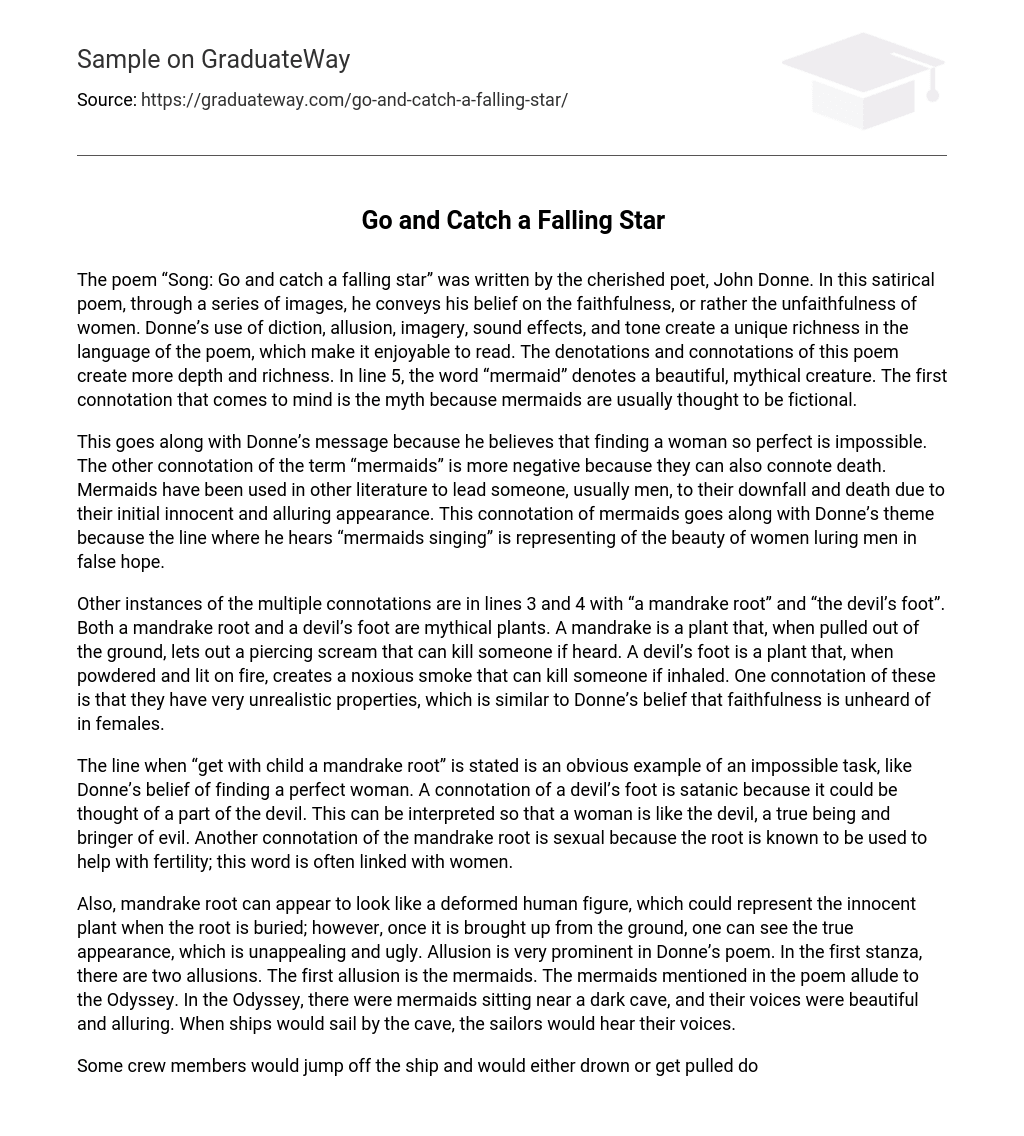John Donne wrote the poem “Song: Go and catch a falling star” to express his thoughts on the faithfulness of women. Through imagery, diction, allusion, sound effects, and tone, Donne creates a captivating language that adds depth to the poem. In line 5, the use of the word “mermaid” refers to a mythical creature, representing a mythological element often associated with beauty.
Donne’s message relates to this notion as he sees finding a woman who is entirely perfect as an unachievable feat. The term “mermaids” holds another meaning, which carries a negative connotation, as they can signify death. In other works of literature, mermaids have been portrayed as leading individuals, typically men, to their downfall and demise, despite their initially innocent and captivating façade. This interpretation of mermaids aligns with Donne’s theme, as the part where he hears “mermaids singing” symbolizes the allure of women that ultimately leads men astray with false hope.
In lines 3 and 4, there are additional instances of the use of multiple connotations involving “a mandrake root” and “the devil’s foot”. Both a mandrake root and a devil’s foot refer to mythical plants. A mandrake is a plant that emits a piercing scream capable of causing death when uprooted. On the other hand, a devil’s foot, when powdered and set alight, produces a toxic smoke that can be fatal if inhaled. One interpretation of these references is that they possess highly unrealistic characteristics, which aligns with Donne’s belief that the quality of faithfulness is uncommon among women.
The statement “get with child a mandrake root” exemplifies an impossible task, similar to Donne’s belief in finding a perfect woman. The connotation of a devil’s foot is satanic, as it can be associated with a part of the devil. This suggests that a woman is comparable to the devil, a real entity that brings evil. Additionally, the mandrake root carries a connotation of sexuality, as it is traditionally used to aid fertility – a word frequently associated with women.
The mandrake root can resemble a deformed human figure, symbolizing its innocence when buried, but revealing its true unattractive appearance when dug up. Allusion plays a significant role in Donne’s poem, with two allusions in the first stanza. The first allusion refers to the mermaids, which is a reference to the Odyssey. In the Odyssey, mermaids sat near a dark cave, enchanting sailors with their beautiful voices as their ships passed by.
In his poem, John Donne references mermaids singing, drawing on the idea of these mythical creatures from Homer’s Odyssey, in which sailors were lured to their deaths by them. The poet suggests that regardless of a woman’s beauty, she cannot be trusted. Another allusion made is to the mandrake root, a plant associated with magic and witchcraft in various myths. In Machiavelli’s play Mandragola, this root is used to concoct a potion that is used to deceive and exploit someone in bed.
This text can be connected to John Donne’s poem as he believed that women were unfaithful and would do anything necessary to accomplish their desires. There are also various references to the mandrake root in Shakespeare’s plays. For instance, in Antony and Cleopatra, one character says, “Give me to drink mandragora that I might sleep out this great gap of time.” Additionally, in Othello, another character states, “Not poppy, nor mandragora, nor all the drowsy syrups in the world, shall ever medicine thee to that sweet sleep.” These lines allude to the magical attributes of the mandrake root, which can induce drowsiness or even eternal sleep.
The connotation of the mandrake root, representing lethality, can be found in the lines from Romeo and Juliet that mention “Shrieks like mandrakes’ torn out of the earth” and in King Henry VI, where the line goes “Would curses kill, as doth a mandrakes’ groan.” Within the poem, this imagery is employed to illustrate how difficult it is to find a faithful woman and to emphasize the rarity of such a lady. The mandrake root, devil’s foot, and mermaid serve as clear illustrations of impossibility. Additionally, the title of the poem, “Go and catch a falling star,” further presents something that is perceived as unattainable and almost magical.
Donne employs hyperbole in the lines “Ride ten thousand days and nights, Till age snow white hairs on thee” to convey that no matter how long a man searches, he will never find an honest woman, even if he looks for one for a thousand days and nights. Similarly, he utilizes hyperbole in the lines “Go and catch a falling star, Though she were true, when you met her, Yet she will be false” to emphasize that every woman, regardless of her initial innocence, will ultimately become corrupted.
The poem incorporates various sound effects such as assonance, alliteration, and a rhyming scheme. For instance, the phrase “Go and catch a falling star” demonstrates assonance with its repeated ‘a’ sounds. Additionally, alliteration is evident in the line “If thou be’st born to strange sights” through the repetition of ‘b’ and ‘s’ sounds. The poem also follows a consistent rhyming pattern, where the first and third lines rhyme, the second and fourth lines rhyme, the fifth and sixth lines rhyme, and the final three lines of each stanza rhyme. These auditory devices serve to captivate readers’ attention and create a smooth and melodic flow throughout the entire poem.





